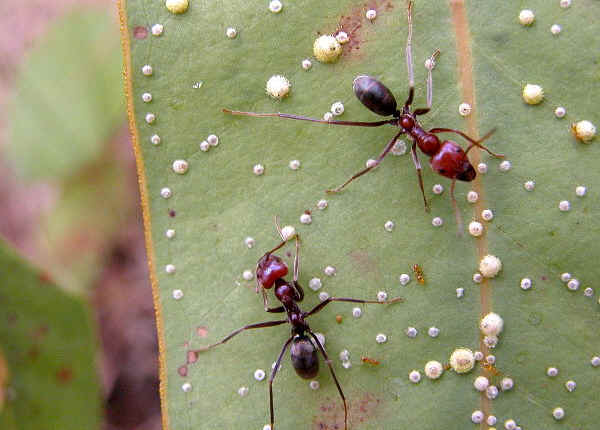Subfamily Dolichoderinae - Meat Ants, Tyrant Ants
Most ants species in the Dolichoderinae subfamily are general predators or scavengers. Some also tend soft-bugs, such as aphids, to collect honeydew and some are associated with butterfly caterpillars. Theirs nests are usually found in the soil, rotten or living wood, in termite mounds and in cracks between rocks.
For the Dolichoderinae ants the petiole is a single segment. The gaster is smooth and does not have constrictions between the segments. The tip of the gaster is absent of sting, and is slit-like, without a circular opening.
Ants of Dolichoderinae are sometimes confused with species of Formicinae because both have a single segmented petiole, lack a sting and are often similar in overall body size and shape.
Dolichoderines can be distinguished from formicines as the tip of the gaster has a slit-like opening while formicines have a small circular opening.
- Large Purple Meat Ant, Mount Ant, Tyrant Ant


- Iridomyrmex purpureus, body length 8mm
- They are quite the large ants, with long legs and a large head. Their body is black in colour with a dark red head. Their nests are built underground, as a sand dome on the surface, usually near foot path. They are common in the Brisbane bush. Please click here for more pictures and information.
- Tyrant Ant


- Iridomyrmex anceps or Iridomyrmex rufoniger, body length 5mm
- The Imperial Blue butterfly caterpillars and pupa always found attending by swarms of black ants. Those ants are either Iridomyrmex anceps or Iridomyrmex rufoniger. Some reference books suggested that the ants come for the honey dew produced by the special secretary organs on the caterpillar body. However, we noticed that the ants also attended the pupa, which were not likely to produce any honey dew. The Caterpillars always attended by the Iridomyrmex ants but not other species. We suspected that the caterpillar and pupa may exploit and take the advantage the chemical signals of those ants. The caterpillar and pupa may secrete the chemical so that the ants think they are their 'Queen' or 'sisters'. This is just a speculation that need more observations to confirm.
- Black Cocktail Ant


- Anonychomyrma sp., body length 5mm
- This ant often be seen attending to various scale-insects and leafhoppers. Those ants get around them for their excretion of 'honey-dew', which contain the excess sugar. Click here for more information.
- Dolly Ant


- Dolichoderus sp., body length 10mm
- Dolly Ants often found tending honeydew-secreting insects. Workers often forage in columns on the ground or on low vegetation and trees. Please also check this page.
- Spider Ant


- Leptomyrmex sp., body length 12mm
- Pictures were taken in rainforest near Mt Nebo. The ant was alone and working very hard moving a roll of leaf material. The have long legs and resemble spiders. When disturbed, they will have their gaster cocked up in the air. More pictures and information please find in this page.
- Reference and Link:
- 1. Dolichoderus spp. - Australian Insect Common Names, CSIRO, 2005.
- 2. Dolichoderus - myrmecos.net, 2005.
- 3. Insects of Australia and New Zealand - R. J. Tillyard, Angus & Robertson, Ltd, Sydney, 1926, p289.


